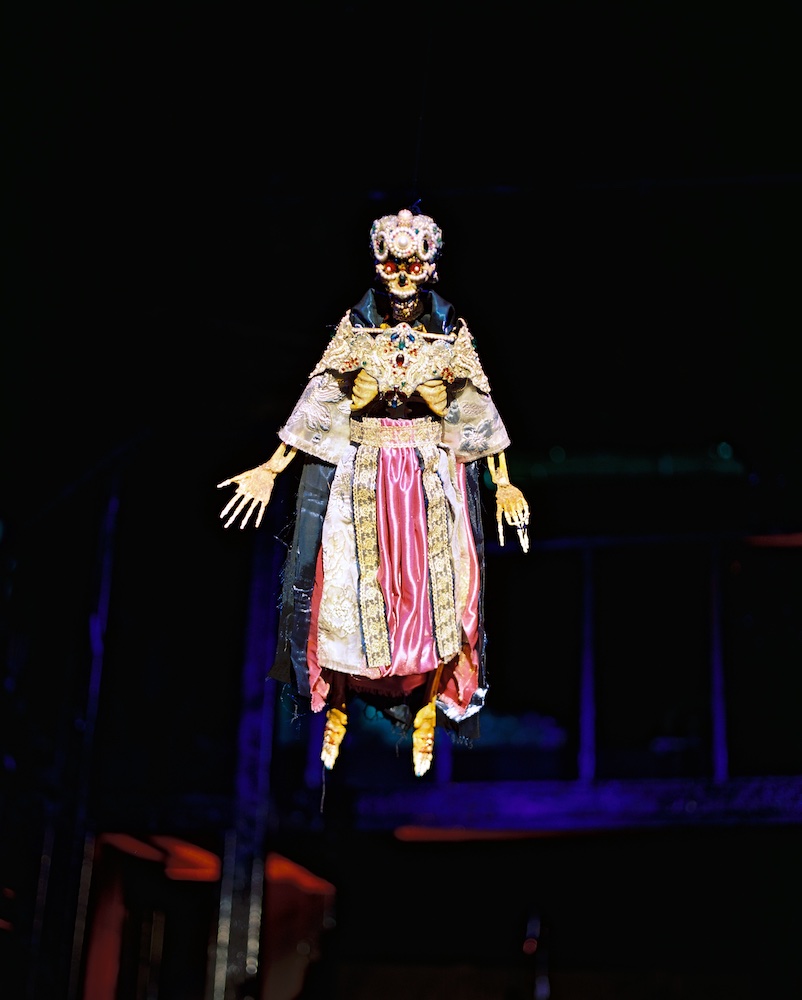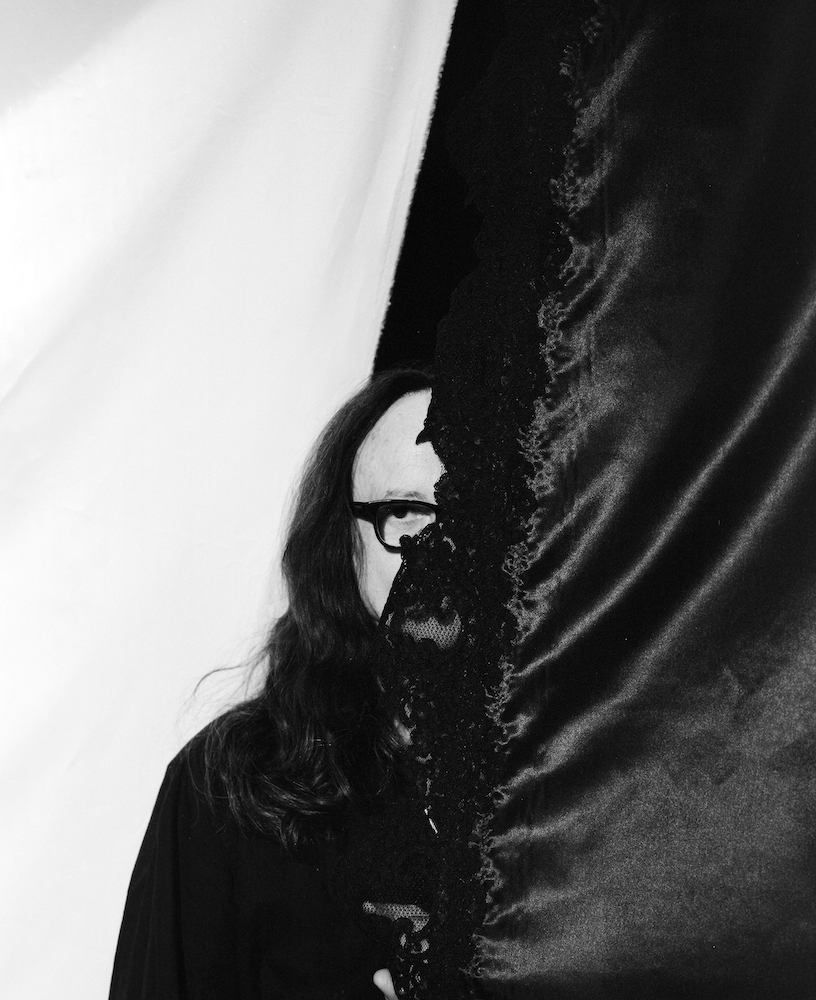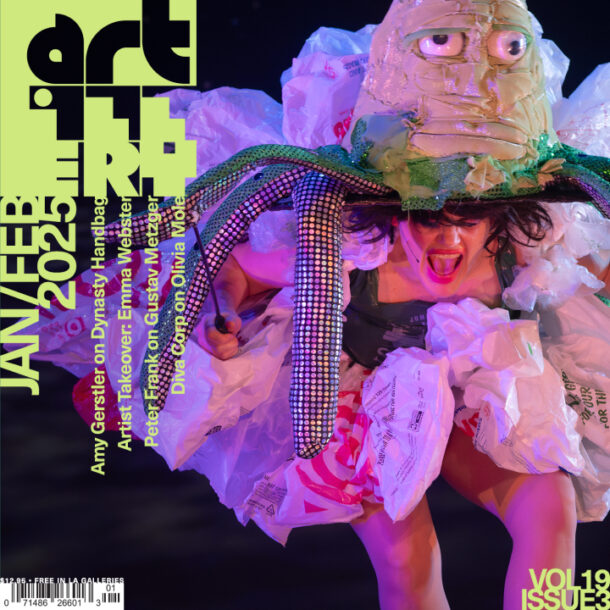One of the performers—if “performer” is the right word—in The Mommy Leaks the Floor, a new work by Asher Hartman staged at New Theater Hollywood (May 16–25), is Pablo, a real-life infant, born earlier this year. Throughout the play, cradled in his mother’s arms on the upper level of the stage, Pablo simply exists—breathing, cooing, occasionally whimpering—while the rest of the piece’s procession swirls around him. In Hartman’s psychic theater, identity is an unstable condition, language is fragmentary, and performance—like the self—is a slippery, porous state. We all want to be that baby again, and well, too bad.
The play unfolds across two levels, an ongoing upstairs/downstairs bifurcation that recurs throughout. Above: mothers and infants, milling about, nearly silent. Below: a disordered sequence of sex, speech, and surreal object-play. José Luis Blondet, Michael Bonnabel, and Philip Littell, Hartman’s frequent collaborators, writhe across the lower stage in a prolonged and self-aware display of poetic soliloquies and libidinal, homo-erotic expression. A puppet made of clear trash bags shaped like leaking nipples emerges in a chef’s hat. A pearlescent liquid soundtrack accompanies its arrival. Soliloquies blur into gibberish or erotic provocation. A character asks, “Does it turn you on to say you hate me?” Later: “May I feel the strength of your weakness?”
New Theater Hollywood, a recent addition to LA’s independent performance landscape, is a small, minimally outfitted black-box venue, an ideal setting for a performance that thrives on disorientation and intimacy. With a set designed by Olivia Mole, the architecture lends itself to Hartman’s interest in the psychic dimensions of performance. His prior work, often staged in collaboration with the now-defunct Machine Project, has used space in unconventional ways to destabilize perception, mixing clown logic, theatrical possession, and intuitive channeling. Here, Hartman continues to explore the permeability of the theatrical frame, triumphantly—if at the expense of coherence.

Set design by Olivia Mole. Photo: Max Pitegoff.
For Jacques Lacan, the preeminent psychoanalytic philosopher of language, desire, and the self, subjectivity is formed through lack, fragmentation, and the mirror stage, an early developmental phase in which the child first experiences the self as other, inaugurating a lifelong tension between the real and the imagined. By connecting performance to infancy in The Mommy Leaks the Floor, Hartman taps into this psychoanalytic framework where identity is fluid, desire is unfulfillable, and the self always leaks out. The baby is not just an object of primordial reverence and care but an allegory for the audience’s own unmoored subjectivity. Like a baby, we are, frustratingly so, not meant to “understand,” we are meant to feel, to surrender to disorientation, and most importantly, to be changed by contact.
As Hartman’s characters grope toward connection, they enact precisely this condition. They whisper, shout, seduce, and degrade. At one point, an actor asks, “Why is it so hard to love?” Then, later: “I want to get ahead in life.” Just as a baby exists in a sensory, preverbal present tense, performance in Hartman’s world resists linear structure, unfolding instead through fragments and impulses. Actors don’t play roles so much as inhabit shifting emotional states, slipping in and out of speech and identity. The show is guided not by plot but by gestures, ruptures, and hauntings. In Lacanian terms, the demand for love always exceeds the possibility of its fulfillment; the desire for the other is, in and of itself, unclosable. In a performance that feels both deliberately crafted and deeply unstable, these questions do not resolve—they simply hover like ghosts.

Asher Hartman. Photo: Calla Henkel and Max Pitegoff.
What feels distinct about the kind of psychic disturbance offered by The Mommy Leaks the Floor—despite familiar ingredients like Lacanian longing, disrupted language, and fourth wall breaks—is that it doesn’t just represent the psyche in crisis; it seems to operate from within one. The actors don’t just perform fragmentation or psychic rupture; they seem, at times, to be caught within its web. The presence of a real baby, for instance, isn’t a symbolic prop so much as a live, unpredictable force—a gesture that sets the tone for the piece’s overall commitment to emotional risk without overdetermining its meaning. By refusing to flatten psychic struggle into a mere aesthetic gesture, Hartman brazenly attempts to stage the unstageable.
I’m not sure I can say whether this “worked” in any conventional sense, but I was glad to be there, pleased to watch these performers give themselves over so fully to the experience. There was something generous, even enviable, about their willingness to dwell in this rote emotional terrain. And through their willingness, the audience is offered an invitation, however brief or strange, to return to a kind of preverbal space of suspended judgment where we might simply allow ourselves to be affected. I left both jealous and moved, uncertain whether I was witnessing failure, catharsis, or just the raw static of being alive.
In one of the show’s most visually memorable moments, a bedazzled skeleton puppet hoisted from the sound booth swings across the audience. Glittered bones hover above a real, breathing child. If there is a thesis here, it might be that life, as Hartman stages it, is an endless loop of affective drama–hysterical, libidinous, ecstatic, and undetermined. The baby upstairs, the skeleton in flight, the crawling figures below, each body enacting its own stage production in a messy, circular continuum of birth, desire, and death. We love mommy, we hate mommy, we want to be loved again and again, and then we die.
One of the actors, Arne Gjelten, begins seated with the audience and eventually joins the cast, being asked, “Are you an actor?” Then, near the end of the show, Gjelten looks out and says: “I was picked. You picked me.” Like the baby upstairs, we are each of us chosen to live out life’s strange, holy theater.


